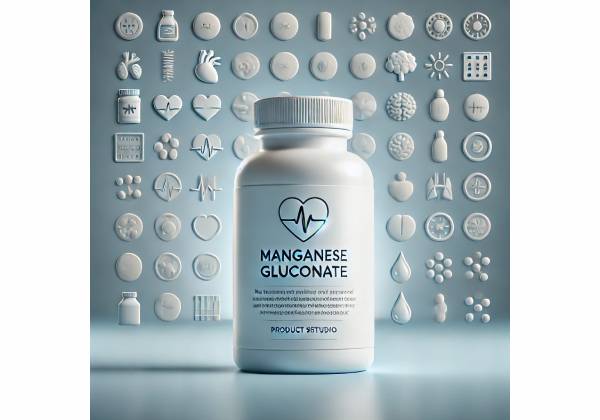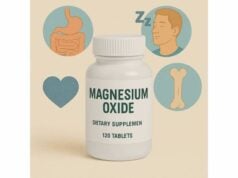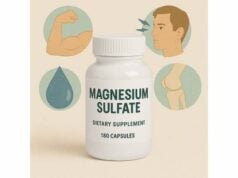
Manganese gluconate is a supplemental form of manganese—the essential trace mineral your body uses to run enzymes that protect cells, build connective tissue and bone, and support normal metabolism. Because manganese is widely available in foods (whole grains, legumes, nuts, tea), deficiency is uncommon. Still, some people consider a supplement to bridge dietary gaps or to support specific life stages. Manganese gluconate dissolves to release manganese ions, which the body can absorb in small amounts and route to tissues like liver and bone. Typical multivitamin doses provide 1–4 mg of elemental manganese per day, which generally aligns with daily needs for most healthy adults. Higher intakes are not better: manganese is a “Goldilocks” nutrient, with potential risks from excess. This guide explains what manganese gluconate can and cannot do, how to use it wisely, who should avoid it, and what the research shows. You will also find dose ranges, timing tips, interactions, and a clear summary of safety limits so you can make an informed decision.
Fast Facts
- Supports antioxidant defenses (MnSOD) and normal bone and connective tissue formation.
- Typical supplement range: 1–4 mg elemental manganese daily; do not exceed regional upper limits (8–11 mg/day).
- Separate from tetracycline or fluoroquinolone antibiotics by several hours to prevent interaction.
- Avoid or use only with medical guidance if you have chronic liver disease, occupational manganese exposure, or a movement disorder.
Table of Contents
- What is manganese gluconate?
- Does manganese gluconate actually work?
- How to take it: dosage and timing
- What changes absorption and effectiveness?
- Safety, side effects, and who should avoid it
- Evidence snapshot: what research shows
What is manganese gluconate?
Manganese gluconate is a salt made by combining manganese (the mineral) with gluconic acid. In the stomach and small intestine, it dissociates and releases manganese ions (Mn²⁺), which the body can absorb in modest amounts. Once absorbed, manganese circulates loosely bound to proteins such as transferrin and albumin, and most of it is taken up by the liver or incorporated into tissues like bone and cartilage. The body contains only a few dozen milligrams of manganese in total, with a quarter to two‐fifths stored in bone. Your cells treat manganese primarily as a cofactor—a helper metal that activates specific enzymes rather than acting like an energy source or structural macronutrient.
Why gluconate? Manufacturers commonly choose gluconate for minerals because the salt dissolves well in water, has a mild taste profile for tablets or powders, and is broadly compatible with other ingredients. Importantly, when comparing manganese supplements, labels typically declare the amount of elemental manganese rather than the weight of the whole salt. That means a capsule that lists “2 mg manganese (as manganese gluconate)” provides 2 mg manganese ions, not 2 mg of the salt compound.
Physiologically, manganese participates in three big areas:
- Antioxidant protection: Manganese is the metal at the heart of manganese superoxide dismutase (MnSOD), the primary enzyme that neutralizes superoxide radicals inside mitochondria.
- Bone and connective tissue formation: Manganese helps activate enzymes (e.g., glycosyltransferases) used to form proteoglycans—key building blocks of cartilage and bone matrix.
- Metabolism and hemostasis: Several manganese-dependent enzymes influence amino acid, cholesterol, and carbohydrate metabolism, and manganese works alongside vitamin K–dependent proteins involved in normal blood clotting.
Dietary manganese is abundant. Whole grains, legumes, nuts, leafy vegetables, coffee, and tea are reliable sources; shellfish and certain fruits also contribute. Because food intakes for most people meet or exceed daily needs, frank deficiency is rare outside special circumstances (e.g., severely restricted diets or long-term parenteral nutrition without manganese).
Absorption of manganese is low on purpose. Typical adult absorption hovers around a few percent, and the body actively reduces uptake when intakes are high. Most excess manganese is excreted via bile into the stool rather than urine. That reliance on bile is why liver and biliary health matter for manganese balance.
Manganese gluconate is one of several common supplemental forms (others include sulfate, citrate, and “amino acid chelates”). For manganese specifically, human data have not established a clear advantage of one form over another in terms of bioavailability or outcomes. Practical considerations—dose, label clarity for elemental content, tolerability, and interactions—matter more than the specific salt for most users.
Does manganese gluconate actually work?
It depends on your goal. As a nutrient supplement, manganese gluconate can help you meet daily manganese needs when your diet is low or when life stage or circumstances increase requirements. As a therapeutic agent promising specific disease outcomes, the evidence is limited and mixed. Here’s a candid look at where manganese gluconate is likely to help and where expectations should stay modest.
Where it helps most—meeting needs and supporting enzyme function:
- If your usual diet lacks whole grains, legumes, nuts, and tea, a modest supplement (for example, 1–2 mg elemental manganese daily) can backstop intake.
- People on very restricted diets or those relying on specialized medical nutrition sometimes need supplemental trace elements, including manganese, to prevent deficiency.
- Inside cells, manganese-dependent enzymes function only if manganese is available. A supplement helps ensure those enzymes can work at full capacity, especially during times of growth or tissue repair.
Bone and connective tissue support:
Manganese helps enzymes synthesize proteoglycans and collagen components. Observational data link adequate manganese status with markers of bone health, and animal studies show deficiency impairs bone formation. In humans, results are inconsistent and often confounded by overall diet quality. A manganese supplement may support bone matrix formation as part of a broader pattern that includes calcium, vitamin D, vitamin K, protein, and weight-bearing exercise. It is not a stand-alone bone remedy.
Antioxidant defense:
MnSOD is critical to mitochondrial resilience. Ensuring adequate manganese supports baseline antioxidant capacity in tissues with high energy demands (muscle, heart, brain). However, taking extra manganese beyond meeting needs does not translate into proportionally higher antioxidant protection. In other words, adequacy matters; excess does not provide extra benefit and may increase risk.
Metabolic effects:
Manganese-dependent enzymes participate in glucose and lipid metabolism. Some small studies and mechanistic data suggest possible links between manganese status and insulin sensitivity or lipid handling, but clinical trials in typical adults have not established manganese supplementation as an effective treatment for metabolic diseases. Any improvements seen in research often come from dietary patterns rich in whole foods that naturally supply manganese alongside fiber, magnesium, and polyphenols.
Neurological considerations:
Manganese is essential for normal brain function. That does not mean more manganese is better for the brain; in fact, chronic excess manganese exposure—especially by inhalation in workplaces—can harm basal ganglia function. Supplements should be used judiciously, especially in people with impaired biliary excretion or a history of occupational exposure.
Bottom line:
For most healthy adults who already meet daily manganese needs through food, adding manganese gluconate is unlikely to produce noticeable benefits. If your diet is low in manganese-rich foods, a low-dose supplement can help you reach about 1.8–2.3 mg/day (typical daily targets for adult women and men, respectively). Meaningful health effects beyond meeting needs are not well supported. Use supplements to ensure adequacy, not to chase unproven outcomes.
How to take it: dosage and timing
How much?
- Everyday support: Many multivitamin/mineral products that include manganese provide 1–4 mg of elemental manganese per day. That range typically covers the daily needs of most healthy adults when combined with diet.
- Single-ingredient products: Stand-alone manganese capsules often contain 5–20 mg per serving—doses that may exceed what you need. If you use a single-ingredient supplement, choose the lowest dose that helps you meet, but not exceed, your daily target.
- Stay under safety caps: Regional authorities set different upper limits for chronic daily intake from all sources (diet plus supplements). A conservative approach for adults is to keep total daily manganese at or below 8–11 mg/day, depending on your location’s guidance. Higher doses should be clinician-directed only.
Label literacy:
- Look for “elemental manganese” on the Supplement Facts panel. That number is what counts, not the weight of “manganese gluconate.”
- Many labels also show % Daily Value (DV). For adults and children ≥4 years, the DV for manganese is 2.3 mg. A product that lists “2.3 mg (100% DV)” signals it’s aligned with typical daily needs.
When to take it:
- Take manganese with a meal if you have a sensitive stomach; manganese salts can occasionally cause mild gastrointestinal upset on an empty stomach.
- If you also take iron, calcium, magnesium, or zinc supplements, consider spacing them through the day. Minerals can compete for transport systems in the gut.
- Antibiotics caution: Do not take manganese within the separation windows advised for tetracyclines or fluoroquinolones (more in the interactions section). A good rule is at least 2 hours before or 4–6 hours after those antibiotics.
Who might consider supplementation:
- Adults with limited dietary intake of whole grains, legumes, nuts, and tea.
- People following restrictive diets where trace mineral variety is low.
- Those on long-term specialized medical nutrition, if a clinician recommends it.
Who should not self-supplement (without medical advice):
- Individuals with chronic liver or biliary disease (reduced manganese excretion).
- People with occupational exposure to manganese (e.g., welding) or with documented high manganese levels.
- Anyone with a movement disorder or parkinsonism—extra manganese could worsen symptoms in susceptible individuals.
- Children and pregnant individuals should only use manganese supplements under professional guidance, selecting conservative doses consistent with life-stage needs.
Practical dosing examples (elemental manganese):
- If your multivitamin provides 2 mg, and your typical diet adds another 1–2 mg, you likely meet daily needs without approaching safety caps.
- If you drink a lot of tea and eat nuts or whole grains daily, you may already reach adequacy from food—so adding a high-dose supplement could be unnecessary.
How long to use:
Think in months to support adequacy. Reassess after 8–12 weeks: look at your diet quality, any side effects, and whether your healthcare provider sees a reason to continue. Manganese does not require cycling, but long-term high doses are unwise.
What changes absorption and effectiveness?
Manganese absorption is dynamic. Your body up-regulates uptake when intakes are low and down-regulates when intakes are high. Several diet and health factors also shift how much manganese you absorb and retain.
Nutrients and minerals that interact:
- Iron status: Low iron stores tend to increase manganese absorption, likely because iron and manganese share transport pathways in the gut. People with iron deficiency may therefore absorb more manganese from the same dose, raising the risk of accumulation if they also supplement manganese.
- Other minerals (calcium, magnesium, zinc): Large doses taken together can compete and reduce absorption efficiency for each other. Spacing mineral supplements by a few hours is a simple way to avoid crowding.
- Phytate and fiber: High phytate foods (bran, some legumes) can bind minerals. However, typical mixed meals still provide enough manganese for most people. Long-term high-phytate, low-variety diets could modestly reduce manganese uptake.
Food matrix and beverages:
- Tea and coffee provide manganese but also contain polyphenols that can complex with minerals. Net effects vary: if tea is a major source of your manganese, you are likely still meeting needs; if you take a manganese pill with tea, absorption may be somewhat lower.
- Fat and protein don’t have strong direct effects on manganese absorption at ordinary intakes.
Health conditions affecting balance:
- Liver and biliary function: The liver excretes manganese into bile. Cholestasis or chronic liver disease reduces excretion, increasing the risk of accumulation even at moderate intakes.
- Age: Infants and young children absorb a higher proportion of manganese than adults. This is one reason to avoid unnecessary supplemental manganese in children unless specifically indicated.
- Genetic and environmental factors: Rare transporter gene variants and occupational exposure to airborne manganese (welding fumes) can alter manganese kinetics and risk profile. People in these categories should avoid self-supplementation.
Medications and timing:
- Tetracycline-class antibiotics (e.g., doxycycline) and fluoroquinolones (e.g., ciprofloxacin) can form poorly absorbed complexes with manganese and other polyvalent cations. Co-administration reduces antibiotic absorption and effectiveness. Separate dosing by several hours.
- Antacids or laxatives containing aluminum, magnesium, or calcium can also interfere with mineral absorption when taken together.
Form matters less than dose and context:
For manganese, current human data do not show clinically meaningful differences among common supplemental salts (gluconate, sulfate, citrate, “bisglycinate”) when equivalent elemental manganese is provided. What matters more is how much you take, what you take it with, and your health status.
Actionable tips to improve effectiveness and safety:
- Take manganese with a regular meal and away from antibiotics.
- If you also take iron or calcium, split dosing across the day.
- If you have liver or biliary issues, avoid manganese supplements unless your clinician prescribes them.
- Favor food first: whole grains, legumes, nuts, and leafy greens supply manganese in a balanced matrix alongside other helpful nutrients.
Safety, side effects, and who should avoid it
Manganese is essential—but like many metals, too much for too long can be harmful. Understanding side effects and safety limits helps you use manganese gluconate wisely.
Common and mild effects:
- At typical supplement doses (1–4 mg/day), most healthy adults report no symptoms.
- Some people experience mild gastrointestinal upset (nausea, stomach discomfort) if they take manganese on an empty stomach. Taking it with food usually helps.
Serious risks with excess intake or impaired excretion:
- Neurological effects: Chronic excess manganese, especially in people who cannot excrete it efficiently, can affect basal ganglia function and lead to symptoms resembling parkinsonism (slowed movement, rigidity, tremor). These effects are well-described in occupational exposure and in certain medical contexts.
- Hepatic/biliary impairment: Because most manganese is eliminated in bile, people with liver disease or cholestasis can accumulate manganese even at moderate intakes.
- Infants and children: They absorb a higher fraction of ingested manganese and are more sensitive to excess. Avoid unnecessary supplemental manganese in this group.
Upper intake limits (chronic daily intake):
- Regulatory bodies set long-term safety caps based on evolving evidence. A practical, conservative approach is to keep your total manganese from diet and supplements at or below 8–11 mg/day unless your clinician advises otherwise. Remember that many multivitamins already supply 1–4 mg/day, and typical diets add several milligrams more.
Medication interactions (important):
- Tetracyclines and fluoroquinolones: Manganese can chelate these antibiotics and block their absorption. Separate by at least 2 hours before or 4–6 hours after the antibiotic dose, following your pharmacist’s guidance.
- Mineral combinations: Large, simultaneous doses of iron, calcium, magnesium, or zinc may mutually reduce absorption. Split doses when practical.
Who should avoid manganese supplements (without medical supervision):
- People with chronic liver or biliary disease, including cholestasis.
- Those with occupational manganese exposure or documented elevated manganese levels.
- Individuals with parkinsonism or other movement disorders.
- Children (unless specifically recommended for a medical indication).
- Anyone with iron deficiency should correct iron first and be cautious with manganese, as low iron increases manganese absorption.
Signs you may be getting too much:
- Neurologic changes (slowness, coordination issues, tremor), chronic headaches, mood changes, or persistent fatigue in the setting of high intake or impaired excretion. These require prompt medical evaluation.
- Unexplained T1 hyperintensity on brain MRI is a radiologic clue sometimes seen in manganese accumulation in specific clinical scenarios.
Best-practice safety rules:
- Use the smallest effective dose that brings your total daily intake into the adequate range.
- Prefer food first; add supplements only when they make a clear difference.
- Reassess periodically—especially if your health status or medication list changes.
Evidence snapshot: what research shows
Status and intake:
Population intake data in Europe and North America suggest most adults consume roughly 2–6 mg/day of manganese from diet alone. That aligns with typical adult adequacy targets (about 1.8 mg/day for women and 2.3 mg/day for men), which helps explain why frank deficiency is rare in free-living adults. Multivitamins that add 1–4 mg/day generally keep total intake within a prudent range.
Absorption and regulation:
Adults typically absorb a small fraction of dietary manganese—often around a few percent—and the body adapts absorption to match needs. Low iron status can increase manganese uptake, while higher intakes suppress it. Most absorbed manganese is eliminated in bile, underscoring the safety importance of normal liver function.
Benefits and limitations:
- Antioxidant role: Manganese is indispensable for mitochondrial antioxidant defense (MnSOD). Ensuring adequacy is important; beyond that, higher intake does not equate to better antioxidant performance.
- Bone/connective tissue: Manganese participates in building the extracellular matrix. While deficiency clearly impairs bone formation in animals, human trials isolating manganese supplementation (without other bone-active nutrients) show inconsistent results.
- Metabolic health: Observational links exist between manganese status and markers of glucose or lipid metabolism, but clinical trials have not established manganese supplements as a treatment for metabolic disease in typical adults.
Risks from excess:
Neurological effects from manganese overexposure—especially inhalational in occupational settings—are well-documented and involve the basal ganglia. Clinical pictures range from manganism to parkinsonism-like features. In non-occupational settings, risk concentrates in people with impaired biliary excretion, high-dose supplementation, or unusual environmental exposure.
Form comparisons:
Head-to-head human trials comparing manganese gluconate to other forms (sulfate, citrate, glycinate) are sparse. Current health-professional guidance emphasizes elemental dose and total intake over form, acknowledging that the body ultimately sees manganese ions. Choosing a form that is well-tolerated, labeled clearly for elemental manganese, and easily spaced from interacting medicines is more important than minor theoretical differences in salt chemistry.
Medication interactions:
Polyvalent cations (manganese, calcium, magnesium, iron) chelate certain antibiotics (tetracyclines, fluoroquinolones) and reduce their absorption—a consistent finding across settings. Simple dose separation prevents this problem.
Consensus takeaways for people-first decisions:
- Most adults meet manganese needs from foods; supplements should fill gaps, not exceed them.
- If you supplement, 1–2 mg/day is typically sufficient unless your clinician advises differently.
- Keep total intake below regional safety caps, consider your iron status and liver health, and separate dosing from interacting medications.
- Watch for symptoms if you have risk factors for accumulation, and involve a healthcare professional in long-term use decisions.
References
- Manganese – Health Professional Fact Sheet 2021 (Guideline)
- Dietary reference values | EFSA 2023 (Guideline)
- Manganese – a scoping review for Nordic Nutrition Recommendations 2023 – PubMed 2024 (Systematic Review)
- Manganese-Induced Parkinsonism: Evidence from Epidemiological and Experimental Studies – PubMed 2023 (Systematic Review)
- Multivalent cations interactions with fluoroquinolones or tetracyclines: A cross-sectional study – PubMed 2021 (Observational Study)
Disclaimer
This article is for educational purposes only and is not a substitute for personalized medical advice, diagnosis, or treatment. Always talk with a qualified healthcare professional before starting, stopping, or changing any supplement, especially if you are pregnant or breastfeeding; have liver, biliary, or neurological conditions; take prescription medications; or are considering doses above typical multivitamin levels. If you experience concerning symptoms while using manganese, seek medical care promptly.
If you found this guide helpful, please consider sharing it on Facebook, X (formerly Twitter), or your favorite platform, and follow us for more clear, evidence-informed nutrition content. Your support helps us continue creating trustworthy resources.










